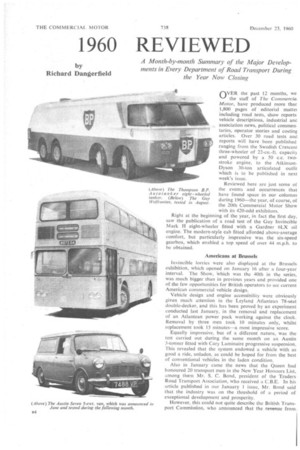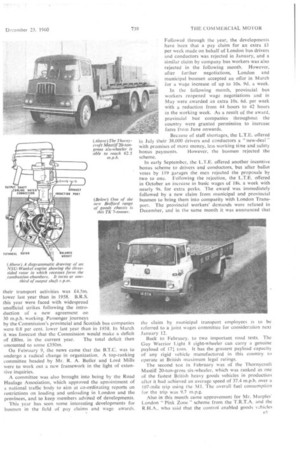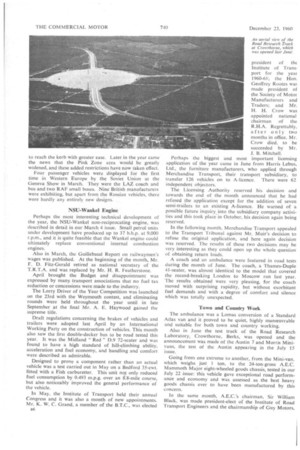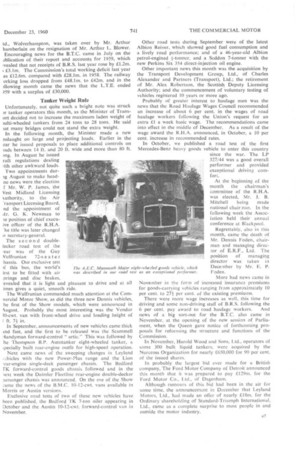1960 REVIEWED
Page 38

Page 39

Page 40

Page 41

If you've noticed an error in this article please click here to report it so we can fix it.
by Richard Dangerfield
A Month-by-month Summary of the Major Developments in Every Department of Road Transport During the Year Now Closing nVER the past 12 months, we the staff of The Commercia Motor, have produced more thar
1,800 pages of editorial matte, including road tests, show reports vehicle descriptions, industrial anc association news, political commen. taries, operator stories and costing articles. Over 30 road tests and reports will have been published ranging from the Swedish Crescent three-wheeler of 22-cu.-ft. capacity and powered by a 50 c.c. twostroke engine, to the AtkinsonDyson 30-ton articulated outfit which is to be published in next week's issue.
Reviewed here are just sonic of the events and occurrences that have found space in our columns during 1960—the year, of course, of the 20th Commercial Motor Show with its 420-odd exhibitors.
Right at the beginning of the year, in fact the first day, saw the publication of a road test of the Guy Invincible Mark II eight-wheeler fitted with a Gardner GLX oil engine. The modern-style cab fitted afforded above-average comfort, but particularly impressive was the six-speed gearbox, which enabled a top speed of over 44 m.p.h. to be obtained.
Americans at Brussels Invincible lorries were also displayed at the Brussels exhibition, which opened on January 16 after a four-year interval. The Show, -which was the 40th in the series, was much bigger than in previous years and provided one of the few opportunities for British operators to see current American commercial vehicle design.
Vehicle design and engine accessibility were obviously given much attention in the Leyland Atlantean 78-seat double-decker, and this has been proved by an experiment conducted last January, in the removal and replacement of an Atlantean power pack working against the clock. Removal by three men took 10 minutes only, whilst replacement took 15 minutes—a most impressive score.
Equally impressive, but of a different nature, was the test carried out during the same month on an Austin 3-tonner fitted with Cary Laminaire progressive suspension. "This revealed that the system endowed a vehicle with as good a ride, unladen, as could be hoped for from the best of conventional vehicles in the laden condition.
Also in January came the news that the Queen had honoured 20 transport men in the New Year Honours List, among them Mr. S. C. Bond, president of the Traders Road Transport Association, who received a C.B.E. In his article published in our January 1 issue, Mr. Bond said that the industry was on the threshold of a period of exceptional development and prosperity.
However, this could not quite describe the British Transport Commission, who announced that the revenue from their transport activities was £4.5m. lower last year than in 1958. B.R.S. this year were faced with widespread unofficial strikes following the introduction of a new agreement on 30 m.p.h. working. Passenger journeys by the Commission's provincial and Scottish bus companies were 0.8 per cent, lower last year than in 1958. In March it was forecast that the Commission would make a deficit of £80m. in the current year. The total deficit then amounted to some £350m.
On February 9, the news came that the B.T.C. was to undergo a radical change in organization. A top-ranking committee headed by Mr. R. A. Butler and Lord Mills were to work out a new framework in the light of extensive inquiries.
A committee was also brought into being by the Road Haulage Association, which approved the appointment of a national traffic body to aim at co-ordinating reports on restrictions on loading and unloading in London and the provinces, and to keep members advised of developments.
This year has seen some interesting developments for busmen in the field of pay claims and wage awards. Followed through the year, the developments have been that a pay claim for an extra fl per week made on behalf of London bus drivers and conductors was rejected in January, and a similar claim by company bus workers was also rejected in the following month. However, after further negotiations, London and municipal busmen accepted an offer in March for a wage increase of up to 10s. 9d. a week.
In the following month, provincial bus workers reopened wage negotiations and in May were awarded an extra 10s. 6d. per week with a reduction from 44 hours to 42 hours in the working week. As a result of the award, provincial bus companies throughout the country were granted permission to increase fares from June onwards.
Because of staff shortages, the L.T.E. offered in July their 38,000 drivers and conductors a " new-deal " with promises of more money, less working time and safety bonus payments. However, the busmen rejected the scheme.
In early September, the L.T.E. offered another incentive bonus scheme to drivers and conductors, but after ballot votes by 119 garages the men rejected the proposals by two to one. Following the rejection, the L.T.E. offered in October an increase in basic wages of 18s. a week with nearly 9s. for extra perks. The award was immediately followed by a new claim from municipal and provincial busmen to bring them into comparity with London Transport. The provincial workers' demands were refused in December, and in the same month it was announced that the claim by municipal transport employees is to be referred to a joint wages committee for consideration next January 12.
Back to February, to two important road tests. The Guy Warrior Light 8 eight-wheeler can carry a genuine payload of 171 tons. It has the greatest payload capacity of any rigid vehicle manufactured in this country to operate at British maximum legal ratings.
The second test in February was of the Thornycroft Mastiff 20-ton-gross six-wheeler, which was ranked as one of the fastest British heavy goods vehicles in production after it had achieved an average speed of 37.4 m.p.h. over a 107-mile trip using the Ml. The overall fuel consumption for the trip was 9.7 m.p.g.
Also in this month came approvement for Mr. Marples' London Pink Zone " scheme from the T.R.T.A, and the R.H.A.. who said that the control enabled goods vzhicles B) to reach the kerb with greater ease. Later in the year came the news that the Pink Zone area would be greatly widened, and these added restrictions have now taken effect.
Four passenger vehicles were displayed for the first time in Western Europe by the Soviet Union at the Geneva Show in March. They were the LAZ coach and bus and two RAF small buses. Nine British manufacturers were exhibiting, but apart from the Russian vehicles, there were hardly any entirely new designs.
NSU-Wankel Engine
Perhaps the most interesting technical development of the year, the NSU-Wankel non-reciprocating engine, was described in detail in our March 4 issue. Small petrol units under development have produced up to 37 b.h.p. at 9,000 r.p.m., and it is quite feasible that the Wankel engine could ultimately replace conventional internal combustion engines.
Also in March, the Guillebaud Report on railwaymen's wages was published. At the beginning of the month, Mr. F. D. Fitz-Gerald retired as national secretary of the T.R.T.A. and was replaced by Mr. H. R. Featherstone.
April brought the Budget and disappointment was expressed by many transport associations that no fuel tax reduction or concessions were made to the industry.
The Lorry Driver of the Year Competition was launched on the 23rd with the Weymouth contest, and eliminating rounds were held throughout the year until in late September at the final Mr. A. E. Haywood gained the supreme title.
Draft regulations concerning the brakes of vehicles and trailers were adopted last April by an International Working Party on the construction of vehicles. This month also saw the first double-decker bus to be road tested this year. It was the Midland " Red " D.9 72-seater and was found to have a high standard of hill-climbing ability, acceleration and fuel economy, and handling and comfort were described as admirable.
Designed to prove a component rather than an actual vehicle was a test carried out in May on a Bedford 35-cwt. fitted with a Fish carburetter. This unit not only reduced fuel consumption by 0.493 m.p.g. over an g.8-mile course, but also noticeably improved the general performance-of the vehicle.
In May, the Institute of Transport held their annual Congress and it was also a month of new appointments. Mr. K. W. C. Grand, a member of the B.T.C., was elected a6
president of the Institute of Transport for the year 1960-61; the Hon. Geoffrey Rootes wat, made president ol the Society of Motor Manufacturers and Traders; and Mr. H. H. Crow was appointed national chairman of the R.H.A. Regrettably, after only two months in office, Mr. Crow died, to be succeeded by Mr. J. B. Mitchell.
Perhaps the biggest and most important licensing application of the year came in June from Harris Lebus, Ltd., the furniture manufacturers, who applied through Merchandise Transport, their transport subsidiary, to transfer 126 vehicles on to A-licence. There were 62 independent objectors.
The Licensing Authority reserved his decision and towards the end of the month announced that he had refused the application except for the addition of seven semi-trailers to an existing A-licence. He warned of a possible future inquiry into the subsidiary company activities and this took place in October, his decision again being reserved.
In the following month, Merchandise Transport appealed to the Transport Tribunal against Mr. Muir's decision to refuse the original application, and here again decision was reserved. The results of these two decisions may be very interesting as they could open up the whole question of obtaining return loads.
A coach and an ambulance were featured in road tests during the month of June. The coach, a Thames-Duple 41-seater, was almost identical to the model that covered the record-breaking London to Moscow run last year. The results obtained were very pleasing, for the coach moved with surprising rapidity, but without exorbitant fuel demands and with a degree of comfort and silence which was totally unexpected.
Town and Country Work The ambulance was a Lomas conversion of a Standard Atlas van and it proved to be quiet, highly manceuvrable and suitable for both town and country working.
Also in June the test track of the Road Research Laboratory, Crowthorne, Berks, was opened and the announcement was made of the Austin 7 and Morris Mini vans, the test of the Austin appearing in the July 15 issue.
Going from one extreme to another, from the Mini-van, which weighs just I ton, to the 24-ton-gross A.E.C. Mammoth Major eight-wheeled goods chassis, tested in our July 22 issue: this vehicle gave exceptional road performance and economy and was assessed as the best heavy goods chassis ever to have been manufactured by this concern.
In the same month, A.E.C.'s chairman, Sir William Black, was made president-elect of the Institute of Road Transport Engineers and the chairmanship of Guy Motors. td., Wolverhampton, was taken over by Mr. Arthur hamberlain on the resignation of Mr. Arthur L. Blower. Encouraging news for the B.T.C. came in July on the iblication of their report and accounts for 1959, which :vealed that net receipts of B.R.S. last year rose by £1,2m. £3.1m. The Commission's total working deficit last year as £12.6m. compared with £28.1m. in 1958. The railway orking loss dropped from £48.1m. to £42m. and in the )Ilowing month came the news that the L.T.E. ended )59 with a surplus of £30,000.
Tanker Weight Rule Unfortunately, not quite such a bright note was struck )r tanker operators this month, as the Minister of Transort decided not to increase the maximum laden weight of tulti-wheeled tankers from 24 tons to 28 tons. He said at many bridges could not stand the extra weight.
In the following month, the Minister made a new nslaught on large and projecting loads. Earlier in the ear he issued proposals to place additional controls on tads between 14 ft. and 20 ft. wide and more than 80 ft. mg. In August he issued raft regulations dealing ,ith other awkward loads. Two appointments durtg August to make headne news were the election f Mr. W. P. James, the Vest Midland Licensing
■ uthority, to the Air 'ransport Licensing Board, rid the appointment of dr. G. K. Newman to le position of chief execuive officer of the R.H.A. he title was later changed o secretary-general.
The second doublelecker road test of the 'ear was of the Guy Vulfrunian 72-s eater hassis. Our exclusive test )-f this bus, the world's irst to be fitted with air prings and disc brakes, evealed that it is light and pleasant to drive and at all imes gives a quiet, smooth ride.
The Wulfrunian commanded much attention at the Comnercial Motor Show, as did the three new Dennis vehicles, he first of the Show models, which were announced in kugust. Probably the most interesting was the Vendor 50-cwt. van with front-wheel drive and loading height of I ft. 7-1 in.
In September, announcements of new vehicles came thick tnd fast, and the first to be released was the Scammell 4andyman forward-control " artic.This was followed by he Thompson B.P. Autotanker eight-wheeled tanker, a specially built rear-engine outfit for high-speed operation. Next came news of the sweeping changes in Leyland rzhicles with the new Power-Plus range and the Lion 'ear-engine single-deck passenger chassis. The Bedford TK forward-control goods chassis followed and in the text week the Daimler Fleetline rear-engine double-decker Jassenger chassis was announced. On the eve of the Show .arne the news of the B.M.C. 10-12-cwt. vans available in Morris or Austin versions.
Exclusive road tests of two of these new vehicles have been published, the Bedford TK 7-ton oiler appearing in October and the Austin 10-12-cwt. forward-control van in November. Other road tests during September were of the latest Albion Reiver, which showed good fuel consumption and a lively road performance; and of a 46-year-old Albion petrol-engined +-Waiter, and a Seddon 7-tonner with the new Perkins Six 354 direct-injection oil engine.
Other important news this month was the acquisition by the Transport Development Group, Ltd., of Charles Alexander and Partners (Transport), Ltd.; the retirement of Mr. Alex Robertson, the Scottish Deputy Licensing Authority; and the commencement of voluntary testing of vehicles registered 10 years or more ago.
Probably of greater interest to haulage men was the news that the Road Haulage Wages Council recommended an increase of about 6 per cent, in the wages of road haulage workers following the Union's request for an extra £1 a week basic wage. The recommendations came into effect in the middle of December. As a result of the wage award the R.H.A. announced, in October, a 10 per cent. increase in recommended rates.
In October, we published a road test of the first Mercedes-Benz heavy goods vehicle to enter this country since the war. The LP 327/44 was a good overall performer and provided exceptional driving comfort,
At the beginning of the month the chairman's committee of the R.H.A. was elected, Mr. J. B. Mitchell being made national chairman. In the following week the Association held their annual conference at Blackpool.
Regrettably, also in this month, came the death of Mr. Dennis Foden, chairman and managing director of E.R.F., Ltd. The position of managing director was taken in December by Mr. E. P. Foden.
More bad news came in November in the form of increased insurance premiums for goods-carrying vehicles ranging from approximately 10 per cent. to 271 per cent, of the existing premiums.
There were more wage increases as well, this time for driving and some non-driving staff of B.R.S. following the 6 per cent, pay award to road haulage workers. And news of a big sort-out for the B.T.C. also came in November, at the opening of the new session of Parliament, when the Queen gave notice of forthcoming proposals for reforming the structure and functions of the Commission.
In November, Harold Wood and Sons, Ltd., operators of some 300 bulk liquid tankers, were acquired by the Norcross Organization for nearly £650,000 for 90 per cent. of the issued shares.
In probably the largest bid ever made for a British company, The Ford Motor Company of Detroit announced this month that it was prepared to pay £129m. for the Ford Motor Co., Ltd., of Dagenham.
Although rumours of this bid had been in the air for some time, the announcement in December that Leyland Motors, Ltd., had made an offer of nearly £18m. for the Ordinary shareholding of Standard-Triumph International, Ltd., came as a complete surprise to most people in and outside the motor industry.




























































































